Fishing for the Future - Tips for a Successful Catch & Release
More Offspring
The largest game fish are often the most valuable in terms
of their ability to produce offspring. The contribution of one
large female fish to the future of a population can exceed
the contribution made by many smaller female fish. It is
not always possible to identify which large fish are females,
so err on the side of conservation and focus on ensuring
the healthy release of the fish. After all, we owe it to the
resource.
Land 'em Quickly!
Try to land big fish quickly. Hooking up with a trophy-sized
fish can be the experience of a lifetime. Landing
the fish quickly is in the best interest of both the
angler and the fish. For the angler, the longer the fight
ensues, the greater the chance for the fish to become
"the one that got away." For the fish, the reduced fight
time can substantially increase the chances for survival
after being released. The longer a fish fights, the more
toxic lactic acid builds up in their body. As a result, an
exhausted fish may initially be able to swim away only
to die several days later.
Tips for Releasing
- Remember, warm water = more stress
-
The prime fishing for many of South Carolina's larger saltwater
game fish is during the warmer months, and water temperature
plays a critical role in the survival of released fish. Warmer
water contains less dissolved oxygen, and fish are under more
stress in a warmer water environment. In these conditions the
fish should be brought to release as quickly as possible.
- Keep fish in the water
-
Never hold a fish out of the water longer than you can hold
your breath - don't even touch the fish if you don't have
to. Most fish can be released without ever touching them.
However, if you do need to remove a large fish from the water,
keep the fish in a horizontal position and support its body
weight. Never hold a fish in a vertical position. This can tear
internal organs and dislocate the spine.
- Take time to aerate
-
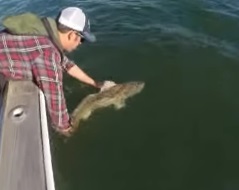
While there is much debate
over whether to move the
fish back and forth or just
hold it gently in the water,
the ultimate goal is to get
water flowing across the gills
until the fish is able to swim off on its own. If there is current
present, hold the fish pointing into the current. If you have
a partner and are fishing from a boat, idle slowly forward to
create a current flow.
Consider that larger predators (sharks) may be attracted to a
distressed fish, and a fish that has not been revived properly
can be an easy meal once released.
- Minimize handling
-
If you must handle the fish or take it out of the water, do it as
quickly as possible. Fish have a slime coating that is designed
to protect them from disease. Always use wet hands or
wet gloves to avoid removing this protective layer. Under no
circumstance should you ever grab a fish by the eyes or insert
your fingers or hand under the gill plate.
Nets or cradles can limit your hands-on contact with the fish.
If you do have to land a fish with a net or cradle, nets that are
rubber, knotless or fine mesh are less abrasive to the fish's skin
and slime coating.
- Photographing in the water
-
A picture is a great way to preserve
the memory of a trophy catch, but
removing a large fish from the water
in order to do so can be harmful to
the fish. Instead, take photos of the
angler reviving the fish. This way, the
fish remains in the water and the
angler is seen close enough to the
fish to still document its size. Also,
be aware of fishery regulations that
may prohibit certain species from
being removed from the water.
- Use lip-gripping devices only when necessary
-
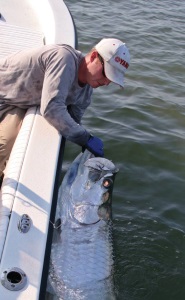
While lip gripping devices can be
useful in handling fish with sharp teeth, recent studies have
shown that these devices may actually cause injury to a fish's
jaw, especially if the fish is thrashing around with the device
in place. Avoid using lip gripping devices on anything but the
most toothy critters, and never use a lip grip device to lift a fish
vertically out of the water.
- Recognize signs of barotrauma
-
Fish that are caught from deep water (generally more than
60 feet) may suffer barotrauma, a condition in which a fish's
swim bladder balloons as it is reeled up through the water
column. Signs of this condition include distended intestines,
bulging eyes, and bloating of the abdomen. In some instances
the stomach may be protruding from the mouth. NEVER try to
push the stomach back down the fish's throat.
- Use descending devices instead of venting
-
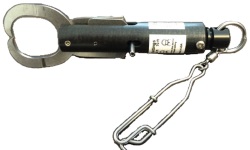
A descending device is an
effective way to send a fish back
down, allowing it to recompress.
Unlike venting, which requires
puncturing the fish, most descending devices
are attached to a fish's mouth, causing little
harm or injury. Pressure activated devices (photo) can be
set to release a fish at a specified depth.
Tips to reduce the fight time
- Don't go after elephants with equipment for squirrels
-
Whether it's "breeder" size red drum, tarpon or cobia,
fishing for larger game fish generally requires specific
tackle and techniques, which are often different than
those used when fishing for smaller fish. Anglers can
increase their chances of successfully landing large fish by
using tackle that is heavy enough to handle the larger fish
they are targeting.
- Use the right line
-
Use the proper line test strength for the size fish you are
targeting. Not only will this have an influence on the fight
time by allowing you to land the fish more quickly, but
it will reduce the possibility of the fish breaking off and
swimming around with a hook and several feet of line
trailing behind. Braided line is a good option, allowing the
use of lighter gear with the ability to shorten the fight due
to line strength and abrasive resistance.
- Have a plan
-
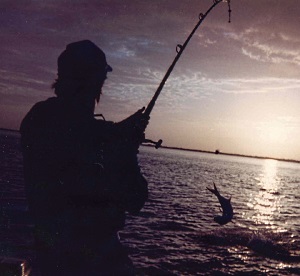
Consider the size of the fish you are targeting and come up
with a strategy beforehand that will give you the best chance
of successfully landing and releasing the fish. For example,
anglers that are anchored while fishing should be prepared
to "unhook" from their anchor in order to chase down a
large fish that makes a long run. Going to the fish instead
of trying to pull the fish to you can significantly reduce the
fight time. Have equipment such as landing devices, pliers
or dehooking tools, a camera and gloves ready and close at
hand.
Use a rod belt or harness for fighting big fish on heavy tackle.
Not only will this prevent bruises created from the rod butt, but
it will provide you more leverage to efficiently battle the fish.
Tips on reducing injury to the fish and
yourself
- Use circle hooks
-
 Non-offset Circle Hook
Non-offset Circle Hook
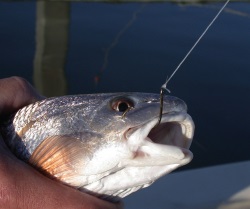
The location of the hook wound is one of the most important
factors that influences the survival of a released fish. If you are
using bait, either live or dead, always use circle hooks. Unlike
the standard "J"-style hooks, circle hooks are designed to roll
as a fish takes the bait, thus resulting in the hook becoming
lodged in the corner of the mouth as opposed to the gut or
throat.
- Take care when removing hooks
-
Never attempt to rip a hook out if it appears a fish has
swallowed the hook. If deeply embedded in the throat, pliers
or a dehooking tool can make removing the hook considerably
easier. If the hook cannot be removed safely, cut the line as
close to the hook as possible. Most (non-stainless) hooks will
simply rust out after a short time.
- Modify your hooks
-
File or bend down the barbs. This allows for a much easier
and quicker release of your fish, with less damage to the fish's
mouth. You will also be thankful for a barbless hook should
you accidentally hook yourself.
- Keep the fish under control
-
Keeping a large fish under control once it has been landed
can be a challenge. With species like tarpon, a firm one- or
two-handed grip on the jaw, while the fish is in the water,
can be an effective way to keep the fish subdued while the
hook is removed. Allowing a fish to bang against the side of a
boat can cause injury to both the fish and angler. A wet towel
placed over the fish's head covering the eyes can also help
calm the fish.

The Tips for a Successful Catch & Release is also available
as a downloadable resource in PDF format. This information
was created with support from Coastal Conservation Association (CCA) South Carolina.







